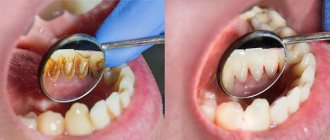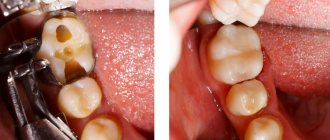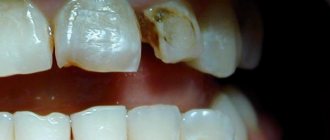Pain after caries treatment: normal or pathological?
Pain after treatment and filling does not always indicate pathology. In 70% of cases, it is the norm, especially if you come to the doctor with advanced, deep caries, progressing or developing into pulpitis.
Mild pain traditionally occurs due to mechanical irritation of the treated tooth - biting on it, chewing hard food, pressing with a finger or a toothpick. This is due to the close fit of the bottom of the carious cavity to the pulp and nerve of the tooth. When you press on the coronal part, the filling puts even more intense pressure on the pulp, which provokes pain. Normally, they are not too pronounced and rather resemble a dull “bone” pain.
There is no need to worry about such pain - over time, your health will definitely return to normal, and the tooth will stop bothering you even with pressure or irritation. Neutralization of uncomfortable sensations is associated with the production of a protective layer of dentin by the pulp, which, as it were, “distances” it from the base of the filling. This process may take up to 2 months.
The first cause for concern is the manifestation of nagging or acute but constant pain, which does not depend on external factors.
Toothache cannot be tolerated. “Muffling” it with strong analgesics is also not recommended, especially if the nature of the symptom is unknown to you.
Leave your phone number. The clinic administrator will call you back.
By leaving a request on the site, you consent to the processing of personal data
Make an appointment
Initial consultation with a dentist
For free!
After filling the cervical part of the tooth (the one located at the junction with the gum), a transient increase in sensitivity is likely. Your tooth can react to cold and hot, as well as sweet and sour. Pay attention to the presence of a “step” or depression between the base of the filling and the original tooth tissue. If you notice an unevenness on the surface, contact your dentist immediately, as this may subsequently lead to inflammation or exposure of the root.
Another variant of the norm may be pain that occurs against the background of:
- Individual response to treatment of dental caries (especially drilling, grinding and polishing);
- X-raying the tooth with special equipment;
- Irritation of soft tissues due to the need to drill out a deep cavity (usually with pulpitis).
Discomfortable sensations go away on their own after 1-8 weeks, depending on the original problem and the individual characteristics of the body.
Tooth hurts after filling
Author of the article: Kondratyeva Tatyana Yuryevna Dentist therapist of the Highest category
This is a very common question on the Internet. Indeed, if a tooth hurts before visiting the dentist, this is understandable, but when the tooth is cured and still hurts...???! Today I will talk about the most common causes of such pain.
If you apply for complicated caries (pulpitis or periodontitis), then treatment ends with filling the canals. We have already talked about the complex anatomy of the canals, so it is difficult to process them, wash them, and get to the smallest branches where microbes can “sit.” And the procedure for removing the nerve itself is associated with trauma, because the doctor has to “cut off” the neurovascular bundle at the apex of the root. As a result, swelling and aseptic inflammation form in the tissues surrounding the root, which the patient feels as pain when biting. If the swelling in the periodontal fissure is significant, then the patient has the feeling of an “overgrown tooth.”
If a living nerve is preserved in one of the branches of the canals, then pain occurs from hot food (although sometimes the inflamed gums also hurt from hot food). Well, if the inflammation that began inside the tooth, despite its treatment, still continues, and this depends on the body’s resistance and on the load on the tooth (let’s assume the patient has significant loss of teeth and needs prosthetics), then a situation arises when an abscess (ulcer) forms, which is opened surgically, and the inflammation is extinguished with the help of antibiotics.
In any case, the less of these sensations the better the quality of canal treatment and filling.
The tooth may hurt even after treatment of uncomplicated caries. So, after treatment of deep caries, sometimes nighttime, spontaneous and long-lasting pain occurs from cold, and then from hot. With such complaints we are already talking about pulpitis. The fact is that the diagnosis of deep caries and the chronic form of pulpitis, when there are no complaints, is practically indistinguishable. After all, what caries is is destroyed tooth tissue stuffed with microbes. And if the cavity is deep, then the infection comes close to the nerve.
All dental therapists are great optimists and are always determined to keep the tooth alive and more functional. Indeed, the idea of removing, say, a finger if it starts to hurt doesn’t occur to anyone??!! Such deep cavities are treated with the application of therapeutic pads, observing the rules of asepsis and antisepsis, and the patient is warned about the possible removal of the nerve subsequently.
After caries treatment, pain sometimes occurs when biting at a certain point.
It happens :
A) if the filling is too high and under anesthesia the patient cannot perform the entire range of movements of the lower jaw, which enable the doctor to grind the filling so that it does not interfere.
B) if post-polymerization stress phenomena occur. The fact is that modern filling materials, light-curing composites, have one negative property (with many positive ones!!!) this is polymerization shrinkage.
In other words, during the curing of the composite, the filling decreases in volume, and since the adhesive bond glues the filling so strongly to the walls of the tooth, they (the walls) begin to experience stress. Moreover, this force is so great that the enamel cracks and first a microscopic gap is formed around the filling, and then quite a significant one. Some patients may have noticed that a matte white stripe first forms around the filling, and then a brown one; this happens when food pigments stain the imperfections around the filling.
One of the reasons for tooth pain after filling is enamel stress
Sometimes these pains are associated with the formation of this microscopic gap under the filling, at the bottom of the carious cavity, or the formation of a pore, a tiny air bubble, in the thickness of the filling, which can form during plastic processing of the composite. In this case, chewing pressure is inadequately transmitted to the pulp and pain occurs. The same symptoms appear if the adhesive, for one reason or another, fails to saturate the tooth tissue well and sensitive areas remain unsealed, causing patients pain when exerting themselves.
C) sometimes after treatment there is sensitivity from cold and discomfort when touching, say with a toothbrush, certain areas of the enamel. Then we talk about superficial sensitivity or hyperesthesia.
Treatment of a tooth involves its preparation with burs, numerous washings, treatment with acids, drying, polishing with abrasive pastes, heating, pleasure, the list of all effects on the tooth is not yet complete. Therefore, sometimes sensitive people with sensitive teeth experience such symptoms. After reading this article, do you get the impression that dental treatment is harmful? I want to reassure you and inspire optimism: for a high quality of life and general health, you need to have beautiful, healthy teeth, which means you need to care for them, treat them, and clean them! And competent specialists, professional dentists who have good equipment, modern technologies and materials, the desire and ability to help you, our dear patients, will help you with this.
Do you have any questions? Get an answer right now using the “Ask a question” form. We will be happy to help you.
»
When is there a reason to worry?
Sometimes doctors recommend that their patients take painkillers after treatment, as they objectively assess the complexity and assume temporary side effects. But symptom relief does not take longer than 3-4 days even after tooth extraction. You must understand that pain is not an enemy at all, but a benefit that signals a problem. And if it appears on an ongoing basis for a week or more, this is a good reason to visit a specialist.
Pay close attention to any accompanying symptoms:
- Fever or slight but constant increase in temperature;
- Bleeding gums around the treated tooth;
- Acute attacks that occur at night;
- A significant increase in sensitivity, encouraging you to completely abandon potential irritants in the form of ice cream or hot tea;
- Numbness of the soft tissues of the jaw at the site of the procedures;
- Darkening or blueness of the gums;
- General malaise and weakness without objective reasons.
Constant aching pain with periodic exacerbations can be associated with overdrying or underdrying of the formed cavity before filling. Both mistakes by the doctor are fraught with complications. When overdrying, persistent irritation of nerve endings can occur, leading to death. If it is not dried enough, the adhesive (sticky material) cannot be absorbed into the dentin, and when the filling shrinks, it comes off from the bottom of the cavity, creating a discharged space here like a vacuum. This also irritates the nerve endings (in professional language the phenomenon is called “debonding”).
In both cases, there is no point in enduring pain for more than a week. Perhaps after 7 days it will really stop bothering you, and the reason for going to the dentist will disappear by itself. But if a week after treatment has passed and the symptom persists, you should immediately visit a doctor.
How to relieve toothache yourself?
- If pain occurs, the right solution would be to take special painkillers. Dentists advise their patients Nurofen, Ketanov, Dexalgin, Baralgin. You can also take regular analgin in tablets. Specialists at Dr. Granov's clinic strongly recommend that you stop taking aspirin and medications containing high concentrations of acetylsalicylic acid. The analgesic effect from them is small, but in high dosages the substance provokes complications, sometimes very dangerous for general health.
- Temporarily stop chewing food on the affected side. Perhaps the symptom is associated specifically with biting - that is, mechanical irritation.
- Under no circumstances use “grandmother’s methods” in the form of heating, lotions or compresses. The procedure can significantly aggravate the current situation and even obviously complicate the process of subsequent treatment, if necessary.
- Antibiotics should not be taken without a doctor's prescription. The selection of antibacterial drugs is a responsible step in which the doctor carefully weighs the benefits and risks. Unauthorized use of antibiotics can lead to unpredictable consequences.
- You can purchase a natural product at the pharmacy - dental drops. It contains plant extracts of valerian, mint and camphor. Soak a tight cotton swab in the solution and apply it to the sore tooth. Change the tampon every 10 minutes until pain subsides.
- You can help yourself by rinsing with decoctions of soothing herbs: mint, lemon balm, chamomile.
What to do if tooth sensitivity does not go away for a long time?
On average, discomfort in the oral cavity should stop after two weeks; for some, this period may be a little longer due to individual characteristics. But if tooth sensitivity persists for a month or longer after caries treatment, this is a reason to definitely consult your doctor.
It is important to accurately describe all your pain sensations so that the dentist can identify the source of the problem at an early stage and eliminate it. It may be that the filling has cracked or the composite material has spread, or this material is simply not suitable. In this case, the filling is removed and another one is placed, or a spacer that reduces sensitivity is placed between it and the inner dental tissue.
If, after the anesthesia has worn off, you feel the sharp edge of the filling that touches the surrounding tissues - tongue, gum, cheek, this means that it is not polished enough. In this case, there is a risk that there is a gap between the filling and the tooth, in which plaque and microbes will accumulate over time, provoking the re-development of caries. To eliminate the problem, the dentist will polish the problem area and thereby prevent possible consequences.
The reasons for tooth sensitivity after caries treatment can be different, and in this case it is important for the patient not to delay a visit to the doctor if they have been bothering them for a long time.
In what cases is it important to visit a doctor?
Visit a specialist urgently if you have:
- Acute toothache;
- Pain combined with bleeding gums;
- Dull pain that sharply worsens when eating cold or hot food (this may indicate untreated chronic pulpitis);
- The temperature has risen;
- Discharge from the gums or changes in the gum tissue are observed.
If you don't trust the dentist who treated your tooth before symptoms began, find a better professional. The specialists at Dr. Granov’s clinic are ready to help you with dental treatment and correct the mistakes of others.
We are responsible for the health of our patients and choose progressive, safe, effective treatment methods.
Toothache after filling therapy
If caries has destroyed part of the tooth structure, this part must be completely removed (clean out the carious cavity) and filled. However, in the case of deep caries or carious lesions in the area between the teeth, it cannot be ruled out that not everything will be detected and removed (in cases of poor quality treatment). Then the filling can cause and even worsen toothache. Even if the decay is completely removed, a deep filling can irritate the dental nerve and cause toothache.
A patient experiencing discomfort should immediately report toothache to their dentist. The dentist can, by conducting an X-ray examination of the affected tooth, more accurately determine the cause of the pain and respond accordingly. For example, if the tooth's nerve is irritated, the filling is removed and an antibiotic is injected into the tooth before the filling is placed again. Such manipulations will help contain the onset of inflammation and reduce pain.










